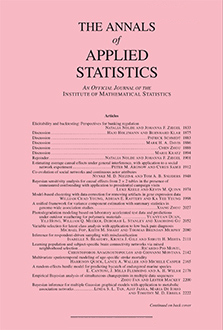Abstract
Storm surge, the onshore rush of sea water caused by the high winds and low pressure associated with a hurricane, can compound the effects of inland flooding caused by rainfall, leading to loss of property and loss of life for residents of coastal areas. Numerical ocean models are essential for creating storm surge forecasts for coastal areas. These models are driven primarily by the surface wind forcings. Currently, the gridded wind fields used by ocean models are specified by deterministic formulas that are based on the central pressure and location of the storm center. While these equations incorporate important physical knowledge about the structure of hurricane surface wind fields, they cannot always capture the asymmetric and dynamic nature of a hurricane. A new Bayesian multivariate spatial statistical modeling framework is introduced combining data with physical knowledge about the wind fields to improve the estimation of the wind vectors. Many spatial models assume the data follow a Gaussian distribution. However, this may be overly-restrictive for wind fields data which often display erratic behavior, such as sudden changes in time or space. In this paper we develop a semiparametric multivariate spatial model for these data. Our model builds on the stick-breaking prior, which is frequently used in Bayesian modeling to capture uncertainty in the parametric form of an outcome. The stick-breaking prior is extended to the spatial setting by assigning each location a different, unknown distribution, and smoothing the distributions in space with a series of kernel functions. This semiparametric spatial model is shown to improve prediction compared to usual Bayesian Kriging methods for the wind field of Hurricane Ivan.
Citation
Brian J. Reich. Montserrat Fuentes. "A multivariate semiparametric Bayesian spatial modeling framework for hurricane surface wind fields." Ann. Appl. Stat. 1 (1) 249 - 264, June 2007. https://doi.org/10.1214/07-AOAS108
Information





